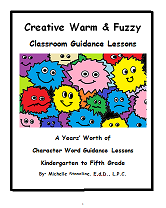History of Sandtray Therapy, Summer 2013, Mercer
by Patty
(Decatur, GA)
The History of Sandtray Therapy
When I enrolled in this class, I knew nothing of sandtrays other than I thought they looked interesting and that I really like the beach, finding sand very therapeutic. I had assumed that this therapy dated back to Freud, especially since I heard it had roots in Jungian theory. I had pictured Jung and Freud having their female patients creating sandtrays and then reading deep, dark, sexual thoughts into the trays. (I saw the movie A Dangerous Method.)
My imagined time frame was not so far off, though there is not a mention of either gentlemen actually using sandtrays themselves. (There is mention of Freud using play therapy, though, and of his daughter Anna using play therapy.) In reality, Dr. Margaret Lowenfeld, a pediatrician and child psychiatrist in the 1920s, was searching for a way to help children express themselves in nonverbal ways. She believed that play was an important developmental part of childhood. She also believed that children think with their hands, using sensory experiences (http://www.sussex-academic.com/sa/titles/psychology/LowenfeldBiography.htm).
In this quest, Dr. Lowenfeld remembered a book by H.G. Wells called Floor Games (Wells, 1911) in which he described his children playing with miniatures. The book discussed the theory and methodology of playing children’s games with models and miniatures. Dr. Lowenfeld used sandtrays and miniatures in her Clinic for Nervous and Difficult Children in London. She called her boxes of sand “The World Technique” since the children she treated created miniature worlds and scenes in these boxes (www.sandplay.org/history.htm).
Dr. Lowenfeld demonstrated the World Technique at a clinical conference in Paris in 1937. Jung attended that conference and analyzed the “world” that Lowenfeld had presented. (www.sandplay.org/history). Other practicing clinicians studied the World Technique, some of whom are described in the following paragraphs.
Goesta Harding from Sweden was influenced by Hanna Bratt, who studied with Dr. Lowenfeld in 1933. Harding also studied with Dr. Lowenfeld in 1949, developing her own type of sandtray therapy called the Erica Method, which still is used in Sweden. The Erica Method of sandtray therapy specifically uses a set number of miniatures, as well as a set number of sand trays. There are specific ways that the miniatures are to be set up in the cabinets. Wet and dry sand are used in the trays, and the wet sand signifies aspects of psychosexual development. The therapist in the sandtray session with the child is nondirective and takes process notes the entire time with a specific forms of things to look for during the sand play (Schaeffer, C., 2010).
Charlotte Buhler, child development researcher at the University of Vienna, also used the World Technique to create a diagnostic test called the World Test. The World Test uses a smaller number of miniatures on a table top instead of in sand. When Lowenfeld and Buhler met in 1950, Dr. Lowenfeld did not like the World Test.
Though unaware of the World Test and the World Technique, in 1937, Erik Homberger, later known as Erik Erikson developed the Dramatic Productions Test. (This is THE Erik Erikson of psychosocial development.) Erikson used miniatures to conduct studies about trauma, family conflict, etc.
Dora Marie Kalff was influential in the development of sand trays and miniatures. She was a neighbor and friend of Emma and Carl Jung in Switzerland, and Jung encouraged her to pursue a degree in psychology. He suggested that she might want to explore Jungian theory with children since that was an unknown area at that time. Kalff did not think that Jungian theory was well suited to children, but when she attended a lecture by Dr. Lowenfeld, she saw the possibility of using the World Technique in a symbolic, Jungian way. Jung encouraged her, and she went to study with Dr. Lowenfeld in 1956.
Kalff incorporated archetypal symbols, and adapted the World Technique to Jungian theory, calling it sandplay therapy. Unlike Lowenfeld, she delayed any interpretation of the sandtray to allow the client time for transformation. She believed that the sandtray was the perfect vehicle for Jungian therapy for children. Kalff and Lowenfeld agreed to differ the names of their sandtray therapies since they embraced different theories in the use of the sandtray (www.sandplay.org/history.htm).
Dr. Gisela De Domenico developed Sandtray-Worldplay through working with Kalff. In the 1980s, she founded Vision Quest sandtray training for mental health professionals. She uses sandtray therapy to explore ancestors and the psyche. She believes that the sandtray is a way to tap into human consciousness, creativity, and the ability to analyze (www.creativecounseling101.com) Other contemporary leaders in sandtray therapy include Dr. Steve Armstrong, otherwise known as Sandtray Steve, and Dr. Barbara Turner, author of The Handbook of Sandplay Therapy.
In conclusion, upon researching this subject, I was surprised that there was not more literature available about sandtray therapy. There is anecdotal, case study literature, but not that much otherwise.
Reference
Schaefer, C., McCormick, J. & Ohnogi, A. (2010). International Handbook of Play Therapy;
Advancements in Assessment, Theory, Research and Practice. Google eBook.
International Handbook of Play Therapy:
Advances in Assessment, Theory, Research and Practice (Google eBook)
Charles Schaefer, Judy McCormick, Akiko Ohnogi
Disclaimer: This website and its content is intended for trained licensed mental health professionals and school certified mental health professionals to use for their clients / students at their own discretion.
*If you ignore the disclaimer above are using these techniques on yourself and you feel any discomfort or upset it is highly suggested that you seek out a licensed mental health professional immediately.
"Beyond Art Therapy" is the concept from Dr. Stangline that combines all creative fields in therapy. It is not the traditional "art therapy" but goes beyond to include sand tray therapy, play therapy, mindfulness, meditation, color therapy, cognitive behavioral therapy, and a vast majority of other therapies.
For any other type of mental health emergency call your local 911 / Police Number immediately.
Dr. Stangline does not offer advice / suggestions to anyone who is not a professional mental health provider, or a student who is studying this field and has questions about mental health programs of study.
See our Exciting Selection of eBooks:
Award Winning:
Creative Counseling 101 eBook
Our Best Seller!
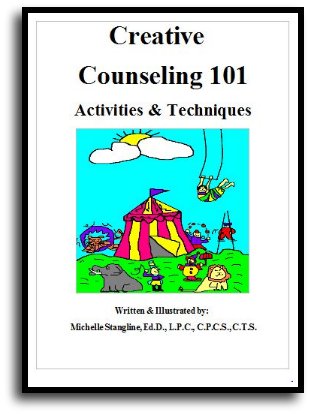
Step By Step Therapy:
Learn how to be a more Creative Therapist with the Book that started it all!
- Graduate School Counseling book used by hundreds of graduate counseling students!
- Includes full color reproducible worksheets with most activities.
- Winner of the Counselor Writer of the Year Award, 2011, Georgia Regional Award
Download Your Copy Today Only $39.95:
See Creative Counseling 101 eBook Information Here:
Get the Set
of all four
eBooks for only $98.95:
An incredible collection of how to do therapy eBooks!
A $159.80 Value,
You Save Over $60!
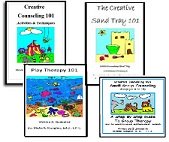
Get your complete set of the Creative Counseling 101.com eBooks by Dr. Michelle Stangline for only $98.95, that's less than $25.00 per eBook (Regular Price is $39.95 for each eBook.).
Your complete set includes:
- Creative Counseling 101
- Creative Group Counseling 101
- Creative Play Therapy 101
- Creative Sand Tray 101
For more information click the link below:
See Complete Set of eBooks For Sale Here:
New!!! "Beyond Art Therapy" 101 eBook
Over 300 pages of Beyond Art Therapy activities and techniques. Learn what I teach graduate counseling students!
See the link below for more information.
Only $39.95
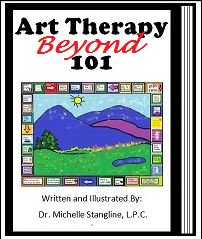
See More Invividual eBooks For Sale:
Sand Tray Therapy 101 eBook:
Learn how to do Sand Tray Therapy or enhance your skills.
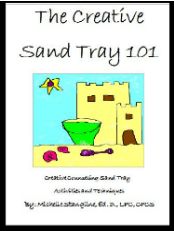
Play Therapy 101 eBook
Learn how to do play therapy or enhance your skills.
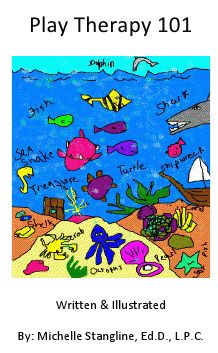
Small Group Counseling eBook For Sale:
Learn how to do creative group therapy and enhance your skills.
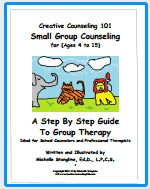
School Counselor Guidance Lesson & Social Stories eBook for sale:
Get a year's worth of school counselor guidance lessons with "Creative Warm & Fuzzy Classroom Guidance Lessons eBook". Introduce your students to the "Warm & Fuzzy Way". Click the link below for more information:
Warm & Fuzzy School Counselor Guidance Lessons eBook
